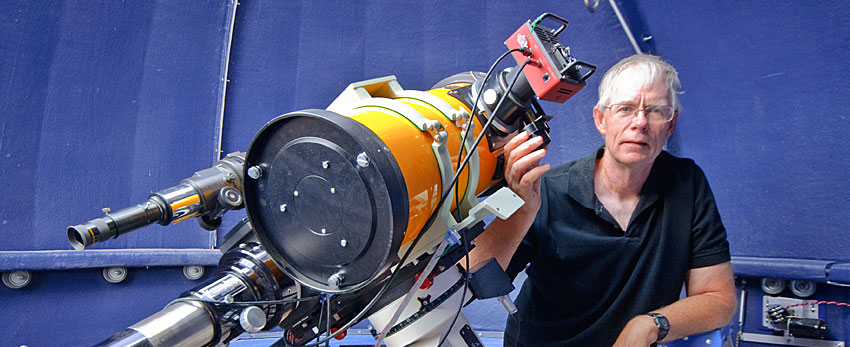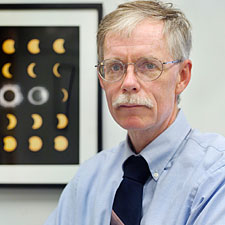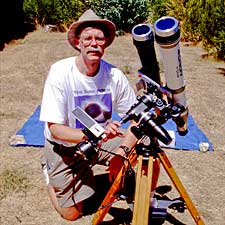My first view though a telescope occurred one summer evening in 1960 when I was 8 years old. I visiting my grandparents on Long Island when a neighbor boy invited me to see the Moon through his new telescope. Just one look and I was hooked! After a relentless six month campaign, my parents conceded to my request and I received a 60mm Tasco refractor for Christmas.
I enjoyed that little scope immensely even though I really didn't know what I was doing. At the same time, my interests were drawn in many other directions: turtles and frogs, chemistry experiments, rock collecting, microscope studies, dinosaurs, electric circuits and ant farms. I was a real science nerd, no question about it.
By the time I reached high school, I was picking up issues of Sky and Telescope during occasional trips to New York City's Hayden Planetarium. The magazine's ads for larger telescopes caught my eye. I soon found myself working in Dad's machine shop to earn enough money to buy an 8-inch Newtonian reflector. Dad took pity on me and agreed to pay for half since $625 was a great deal of money for a teenager back in the 1960s.
The wonderful views afforded by this telescope led me to consider a career in astronomy. It was an exciting time with the Apollo Moon missions and NASA spacecraft exploring the planets. After a several year wait, I traveled to North Carolina to see the 1970 total eclipse of the Sun. I expected it to be a once in a lifetime experience, but as soon as totality ended I knew I had to see another eclipse. This was a game changing event for me although I didn't realize it at the time.
After a semester in the University of Arizona's astronomy program, I switched to physics because it was a more versatile degree while still leaving the door open to astronomy. I transferred to Wagner College so I could commute from home. While attending graduate school at the University of Toledo, my research thesis on red dwarf stars (BY Draconis Syndrome) brought me back to Arizona to make photometric observations from Kitt Peak National Observatory. I was excited to be working at one of the leading astronomical centers on Earth.
A background in physics and computer programming helped land my first job with a software company holding NASA contracts. After two years of writing data analysis programs for satellites and a stint as a telescope operator for NASA's International Ultraviolet Explorer spacecraft, I was hired by the Infrared Astronomy Branch at Goddard Space Flight Center (Greenbelt, MD). I worked with a group of scientists on the Infrared Heterodyne Spectrometer. We took this instrument on frequent trips to Kitt Peak and later to Mauna Kea Observatory in Hawaii where we made infrared spectroscopic observations of planetary atmospheres. Back at Goddard, I spent months developing software and analysing our data.
Over the years, I participated in many solar eclipse expeditions and wrote computer programs to generate eclipse predictions and maps. In 1992, the Nautical Almanac Office's long series of solar eclipse circulars were terminated due to budget cuts. In this vacuum, I accepted the responsibility of producing the new NASA Eclipse Bulletins series with the help of Canadian meteorologist Jay Anderson. When the Internet exploded onto the scene, I created the NASA Eclipse Web Site. It was soon followed by the MrEclipse.com Web Site that focuses on eclipse photography. I also collaborated with Mark Littmann and Ken Willcox to write Totality: Eclipses of the Sun as a comprehensive book on the subject for the general public.
In 2003, the International Astronomical Union honored my work on eclipses by naming Minor Planet 14120 after me. I must confess I was delighted to share my name with a piece (a very small piece) of the Solar System.
Throughout my professional career, I remained an enthusiastic amateur astronomer as I dabbled in astrophotography, film hypersenstization and Schmidt cameras. But the light polluted skies of the East Coast made celestial imaging a challenging endeavour. I dreamed of someday building an observatory far from the interfering lights of big cities.
On a 1995 eclipse trip to India, I chanced to meet a high school chemistry teacher named Patricia Totten. Now I'm not the sharpest knife in the drawer when it comes to the fair sex, so it took me a few years to fully appreciate this remarkable woman. She shared my passion for eclipses, science and photography as we traveled the world together. Long story short, we eventually got married in 2006. Pat encouraged me to find a place with dark skies for a retirement home and observatory so I bought property in Arizona Sky Village.
As my retirement from NASA approached, I worked hard to complete several publications that would become my Magnum Opus. The NASA Five Millennium Canon of Solar Eclipses and Five Millennium Canon of Lunar Eclipses were coauthored with my long time mentor and friend Jean Meeus. These comprehensive publications of maps and diagrams were accompanied by two additional volumes Five Millennium Catalog of Solar Eclipses and Five Millennium Catalog of Lunar Eclipses containing supplementary tables and supporting data.
Several weeks after my 2009 retirement, work began on the construction of my observatory in Portal, Arizona. Although I still lead eclipse expeditions for Spears Travel and I continue to maintain the NASA Eclipse Web Site as a Goddard Scientist Emeritus as well as my eclipse photography site MrEclipse.com, most of my time is now spent under the dark night skies visible from Bifrost Astronomical Observatory. Carpe noctem!



